Detection of the Lunar Surface Soil Permittivity with Megahertz Electromagnetic Wave
Abstract
:1. Introduction
2. Physical Model and Formulations
2.1. Physical Model and Lunar Ionosphere
2.2. The Permittivity and Reflection of the Lunar Surface Soil
2.3. Dusty Plasma Permittivity and ISMM
3. Results and Discussion
3.1. Common Detection with Three Typical Missions
3.2. Lunar Illumination Intensity
3.3. Characteristics of Dust Particles
3.4. Dust Particle Charging Process
4. Conclusions
Author Contributions
Funding
Institutional Review Board Statement
Informed Consent Statement
Data Availability Statement
Conflicts of Interest
References
- Cherkasov, I.I.; Shvarev, V.V. Soviet investigations of the mechanics of lunar soils. Soil Mech. Found. Eng. 1973, 10, 252–256. [Google Scholar] [CrossRef]
- Yushkova, O.V.; Yuhkov, V.V. Determininng the Complex Dielectric Permittivity of Soil in the Bistatic Radar Regime. Radiophys. Quantum Electron. 2018, 60, 681–687. [Google Scholar] [CrossRef]
- Hongo, K.; Toh, H.; Kumamoto, A. Estimation of bulk permittivity of the Moon’s surface using Lunar Radar Sounder on-board Selenological and Engineering Explorer. Earth Planets Space 2020, 72, 137. [Google Scholar] [CrossRef]
- Lunar Sample Preliminary Examination Team (1). Preliminary examination of lunar samples from Apollo 11. Science 1969, 165, 1211–1227. [Google Scholar] [CrossRef]
- Hiesinger, H.; James, W.H., III. New views of lunar geoscience: An introduction and overview. Rev. Mineral. Geochem. 2006, 60, 1–81. [Google Scholar] [CrossRef]
- De Bernardis, P.; Ade, P.A.; Bock, J.J.; Bond, J.R.; Borrill, J.; Boscaleri, A.; Coble, K.; Crill, B.P.; Gasperis, G.D.; Farese, P.C.; et al. A flat Universe from high-resolution maps of the cosmic microwave background radiation. Nature 2000, 404, 955–956. [Google Scholar] [CrossRef]
- Mao, W.; Xu, G. Study on propagation properties of electromagnetic waves through a magnetized, collisional and inhomogeneous plasma under oblique incidence. AIP Adv. 2019, 9, 085305. [Google Scholar] [CrossRef] [Green Version]
- Vasil’ev, M.B. Radio transparency of circumlunar space using the Luna-19 station. Cosm. Res. 1974, 12, 102–107. [Google Scholar]
- Vyshlov, A.S. Preliminary results of circumlunar plasma research by the Luna 22 spacecraft. Space Res. XVI 1976, 945–949. Available online: https://ui.adsabs.harvard.edu/abs/1976spre.conf..945V (accessed on 1 April 2021).
- Vyshlov, A.S.; Savich, N.A. Observations of the occultation of radio sources by the moon and the characteristics of the lunar plasma. Kosm. Issled. 1978, 16, 551–556. [Google Scholar]
- Stubbs, T.J.; Glenar, D.A.; Farrell, W.M.; Vondrak, R.R.; Collier, M.R.; Halekas, J.S.; Delory, G.T. On the role of dust in the lunar ionosphere. Planet. Space Sci. 2011, 59, 1659–1664. [Google Scholar] [CrossRef] [Green Version]
- Thompson, T.W.; Masursky, H.; Shorthill, R.W.; Tyler, G.L.; Zisk, S.H. A comparison of infrared, radar, and geologic mapping of lunar craters. Moon 1974, 10, 87–117. [Google Scholar] [CrossRef]
- Hwu, S.; Upanavage, M.; Sham, C. Lunar Surface Propagation Modeling and Effects on Communications. In Proceedings of the 26th International Communications Satellite Systems Conference (ICSSC), San Diego, CA, USA, 10–12 June 2008. [Google Scholar] [CrossRef] [Green Version]
- Pabari, J.P.; Acharya, Y.B.; Desai, U.B.; Merchant, S.N.; Krishna, B.G. Radio Frequency Modelling for Future Wireless Sensor Network on Surface of the Moon. Int. J. Commun. Netw. Syst. Sci. 2010, 3, 395–401. [Google Scholar] [CrossRef] [Green Version]
- Baishya, S.K.; Das, G.C. Dynamics of dust particles in a magnetized plasma sheath in a fully ionized space plasma. Phys. Plasmas 2003, 10, 3733–3745. [Google Scholar] [CrossRef]
- Cao, Y.; Li, H.; Wang, Z.; Wu, Z. Propagation characteristics of oblique incident terahertz wave in non-uniform dusty plasma. Int. J. Antennas Propag. 2016, 2016, 1–6. [Google Scholar]
- Chen, W.; Yang, L.; Huang, Z.; Guo, L. Propagation characteristics of THz waves in space-time inhomogeneous and fully ionized dusty plasma sheath. J. Quant. Spectrosc. Radiat. Transf. 2019, 232, 66–74. [Google Scholar] [CrossRef]
- Wang, M.; Li, H.; Dong, Y.; Li, G.; Jiang, B.; Zhao, Q.; Xu, J. Propagation matrix method study on THz waves propagation in a dusty plasma sheath. IEEE Trans. Antennas Propag. 2015, 64, 286–290. [Google Scholar] [CrossRef]
- Chen, X.Y.; Shen, F.F.; Liu, Y.M.; Ai, W.; Li, X.P. Improved Scattering-Matrix Method and its Application to Analysis of Electromagnetic Wave Reflected by Reentry Plasma Sheath. IEEE Trans. Plasma Sci. 2018, 46, 1755–1767. [Google Scholar] [CrossRef]
- Grobman, W.D.; Blank, J.L. Electrostatic potential distribution of the sunlit lunar surface. J. Geophys. Res. 1969, 74, 3943–3951. [Google Scholar] [CrossRef]
- Mishra, S.K.; Misra, S. Charging and dynamics of dust particles in lunar photoelectron sheath. Phys. Plasmas. 2019, 26, 053703. [Google Scholar] [CrossRef]
- Zhang, Y.; Xu, G.; Zheng, Z. Terahertz waves propagation in an inhomogeneous plasma layer using the improved scattering-matrix method. Waves Random Complex Media 2020. [Google Scholar] [CrossRef]
- Ge, D.; Shi, Y.; Wu, J. The research on the dielectric tensor of weakly ionized dust plasma. Acta Phys. Sinica. 2009, 58, 5507–5512. [Google Scholar]
- Li, H.; Wu, J.; Zhou, Z.X.; Yuan, C.; Jia, J. The dielectric function of weakly ionized dusty plasmas. Phys. Plasmas 2016, 7, 073301. [Google Scholar] [CrossRef]
- Jia, J.; Yuan, C.; Gao, R.; Liu, S.; Yue, F.; Wang, Y.; Zhou, Z.-X.; Wu, J.; Li, H. Transmission characteristics of microwave in a glow-discharge dusty plasma. Phys. Plasmas 2016, 23, 073705. [Google Scholar] [CrossRef]
- Li, H.; Wu, J.; Zhou, Z.; Yuan, C. Propagation of electromagnetic wave in dusty plasma and the influence of dust size distribution. Phys. Plasmas 2016, 23, 073702. [Google Scholar] [CrossRef]
- Gerasimovic, B.P. On the Correction to Saha’s Formula for Small Deviations from Thermodynamic Equilibrium. Proc. Natl. Acad. Sci. USA 1927, 13, 180–185. [Google Scholar] [CrossRef] [PubMed] [Green Version]
- Freeman, J.W.; Ibrahim, M. Lunar electric fields, surface potential and associated plasma sheaths. Earth Moon Planets 1975, 14, 103–114. [Google Scholar] [CrossRef]
- Yu, H.; Xu, G.; Zheng, Z. Transmission characteristics of terahertz waves propagation in magnetized plasma using the WKB method. Optik 2019, 188, 244–250. [Google Scholar] [CrossRef]
- Popel, S.I.; Zelenyi, L.M.; Atamaniuk, B. Dusty plasma sheath-like structure in the region of lunar terminator. Phys. Plasmas 2015, 22, 123701. [Google Scholar] [CrossRef]
- Vladimirov, S.V. Propagation of waves in dusty plasmas with variable charges on dust particles. Phys. Plasmas 1994, 1, 2762–2767. [Google Scholar] [CrossRef]
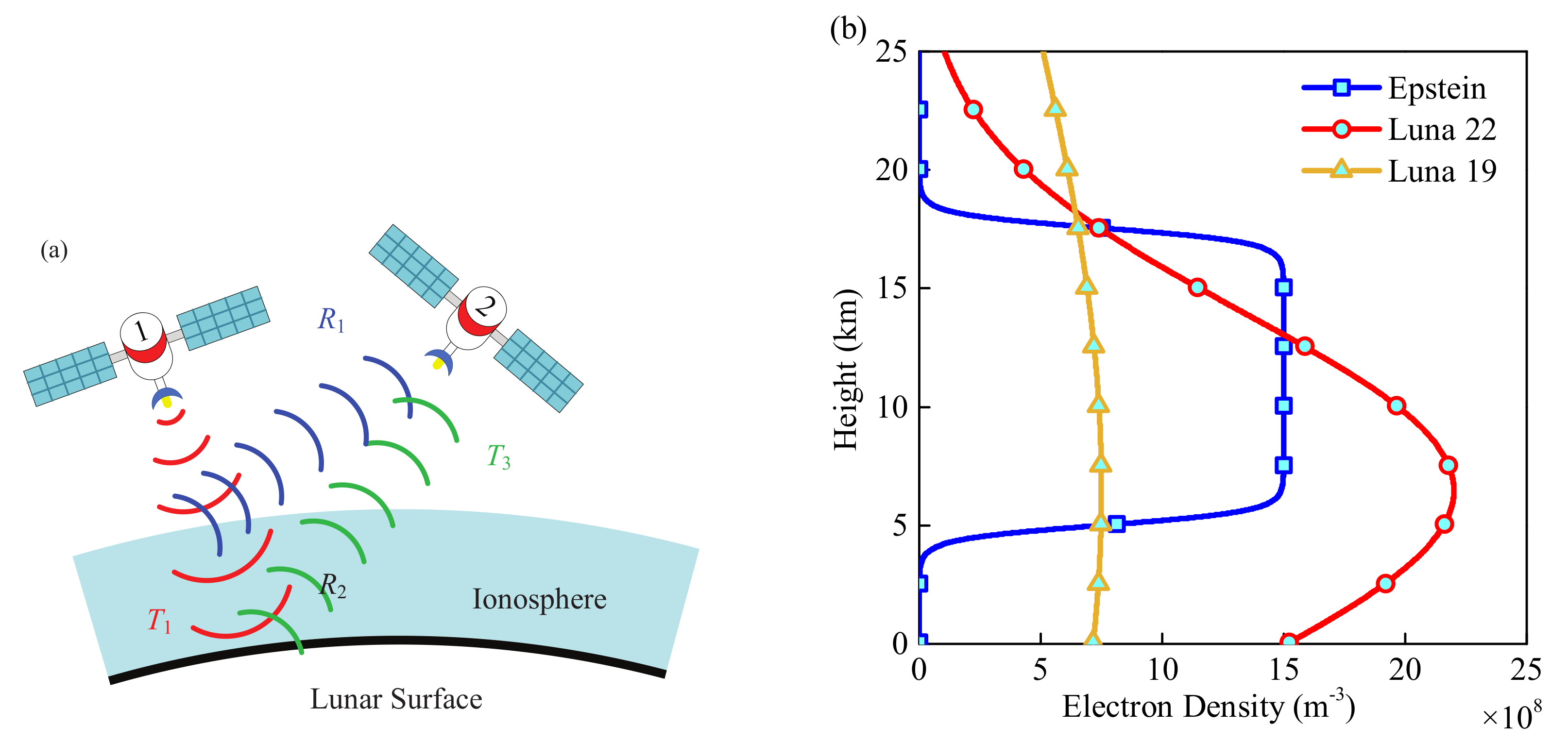
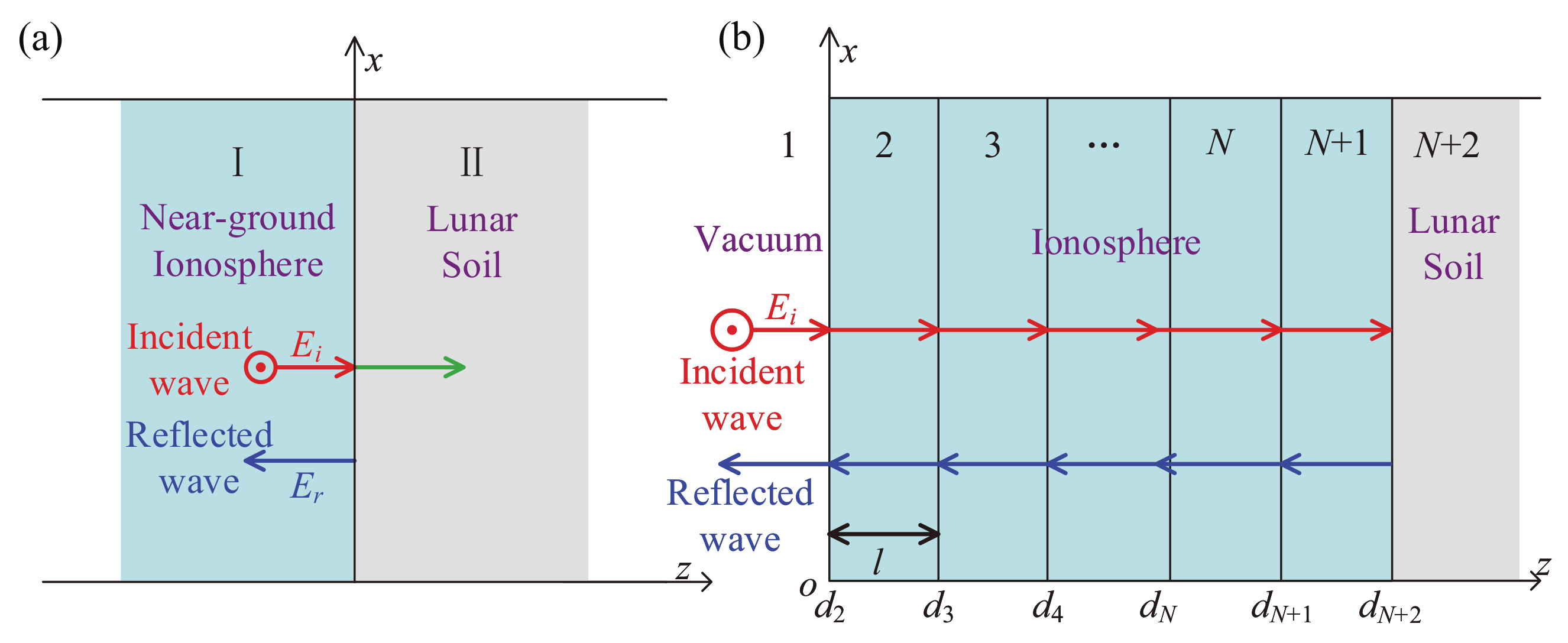
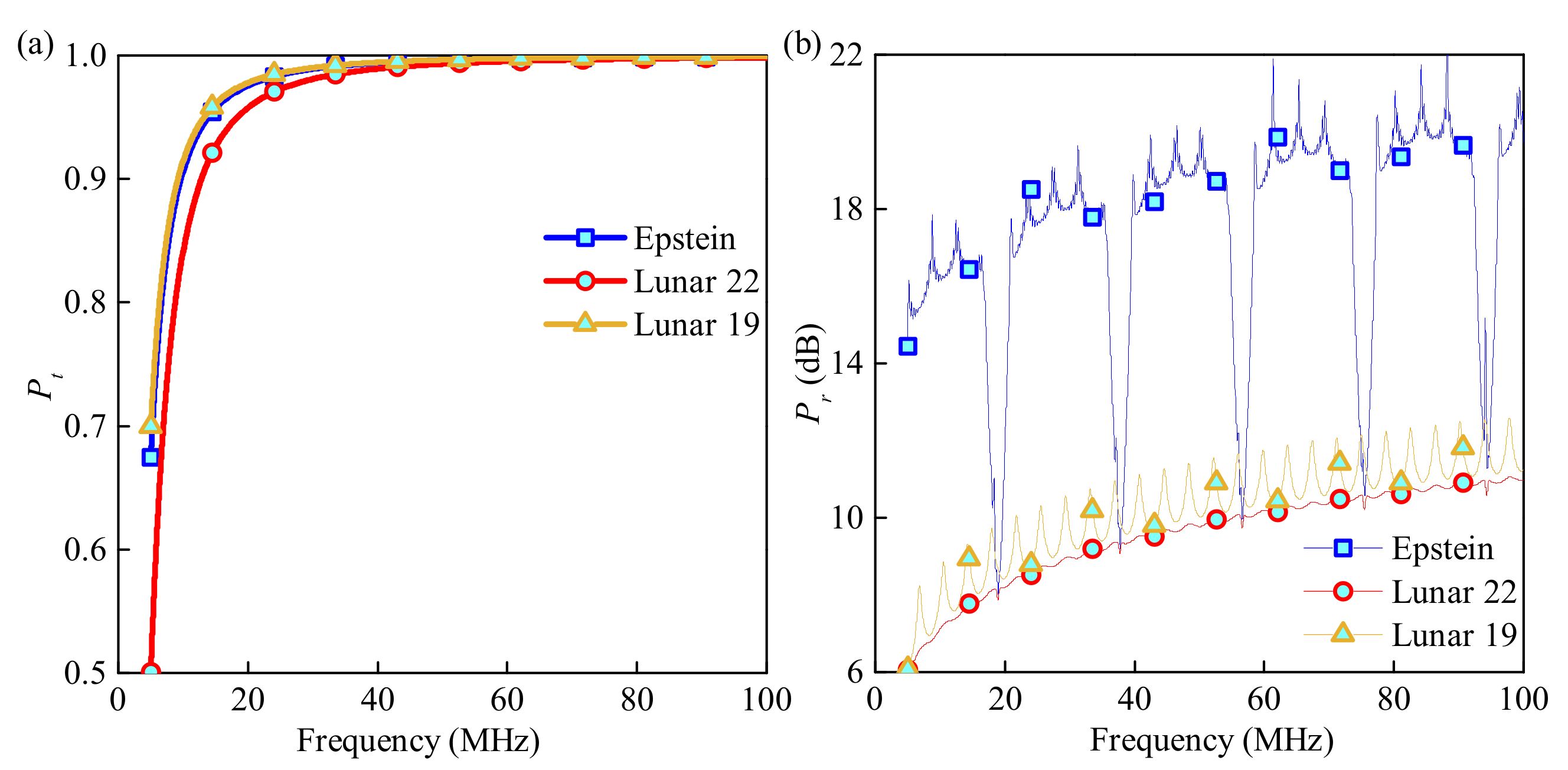
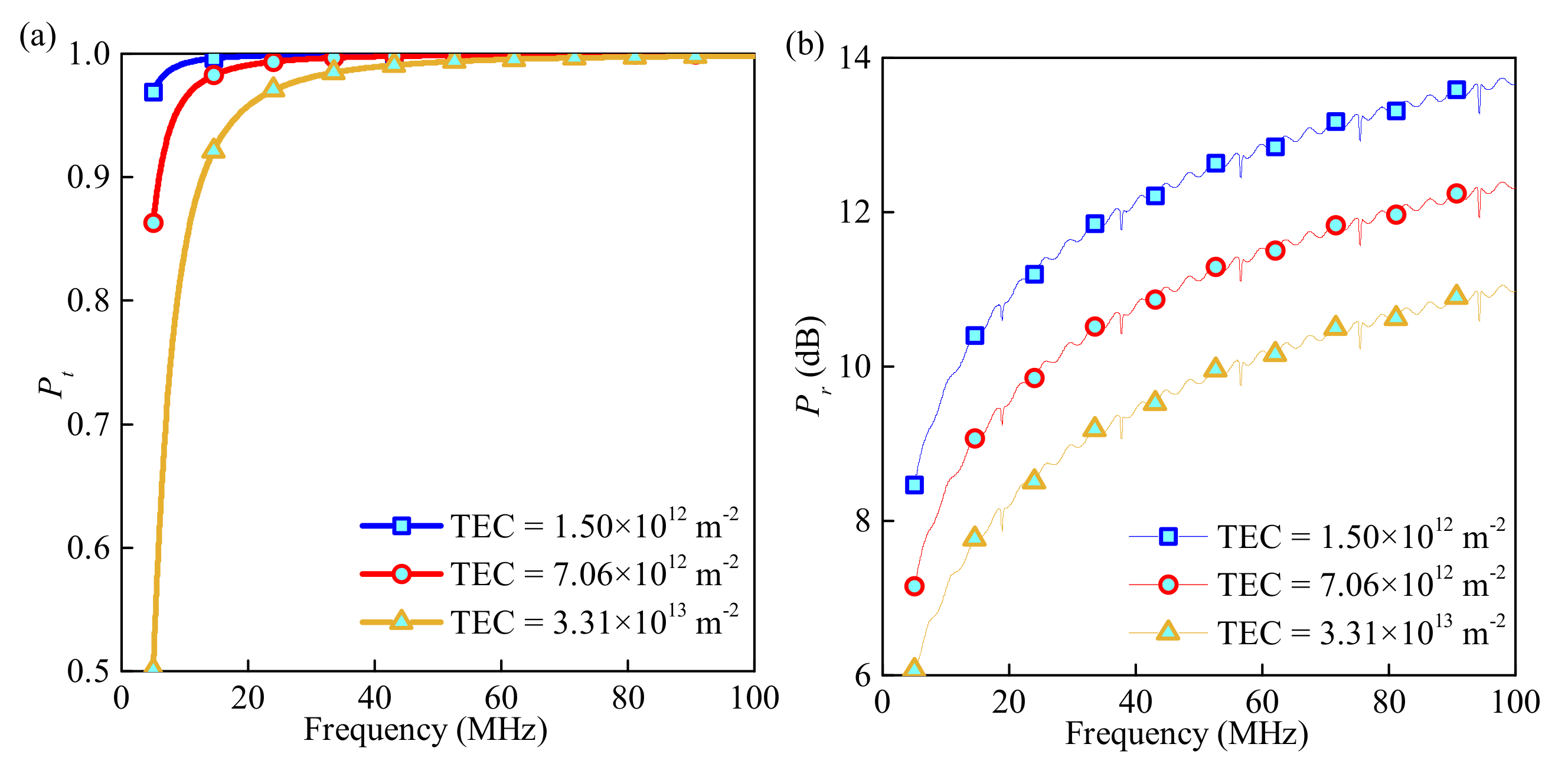

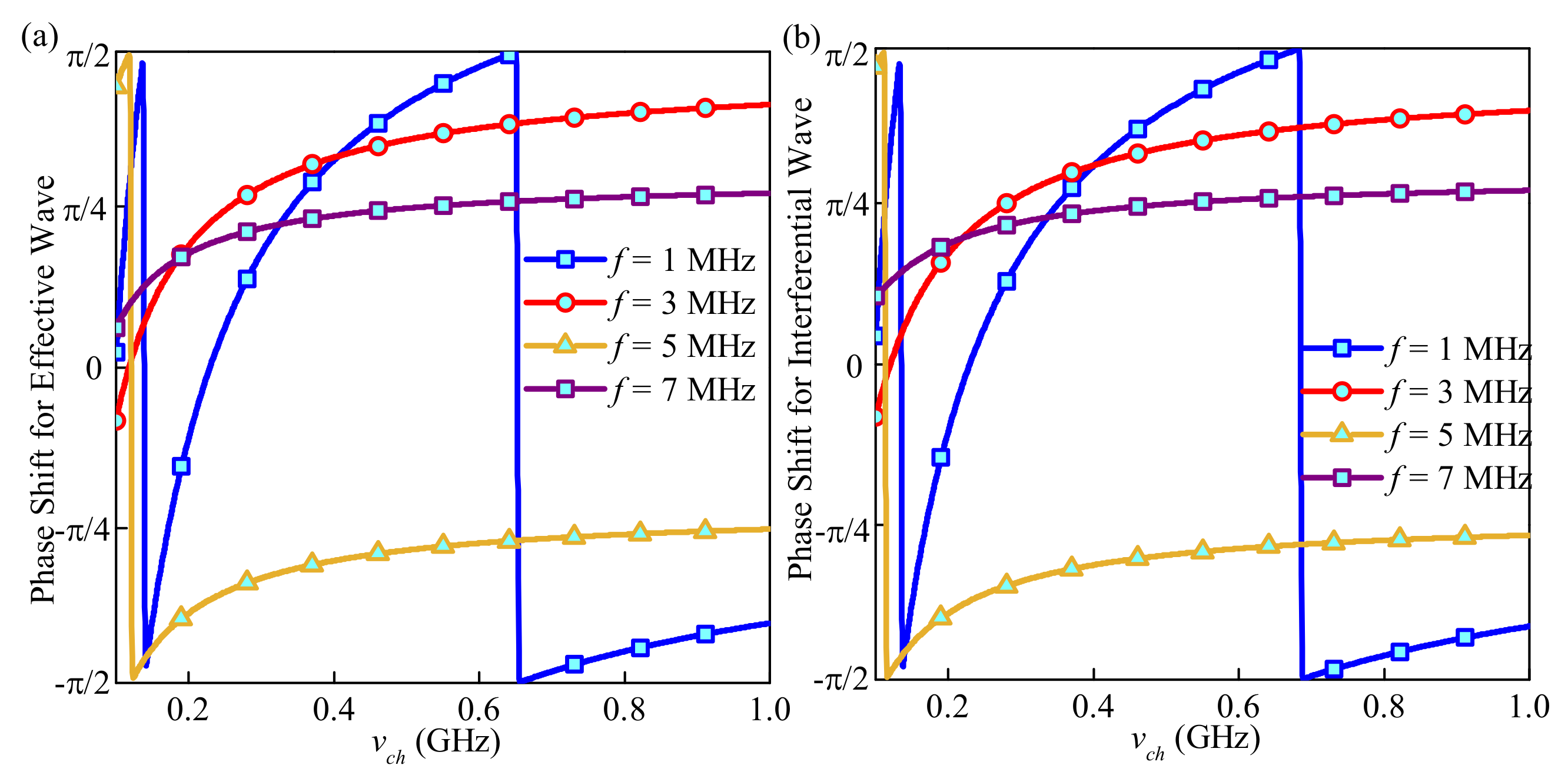
Publisher’s Note: MDPI stays neutral with regard to jurisdictional claims in published maps and institutional affiliations. |
© 2021 by the authors. Licensee MDPI, Basel, Switzerland. This article is an open access article distributed under the terms and conditions of the Creative Commons Attribution (CC BY) license (https://creativecommons.org/licenses/by/4.0/).
Share and Cite
Rao, Q.; Xu, G.; Mao, W. Detection of the Lunar Surface Soil Permittivity with Megahertz Electromagnetic Wave. Sensors 2021, 21, 2466. https://doi.org/10.3390/s21072466
Rao Q, Xu G, Mao W. Detection of the Lunar Surface Soil Permittivity with Megahertz Electromagnetic Wave. Sensors. 2021; 21(7):2466. https://doi.org/10.3390/s21072466
Chicago/Turabian StyleRao, Qingwen, Guanjun Xu, and Wangchen Mao. 2021. "Detection of the Lunar Surface Soil Permittivity with Megahertz Electromagnetic Wave" Sensors 21, no. 7: 2466. https://doi.org/10.3390/s21072466





